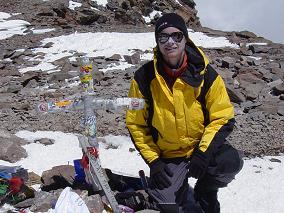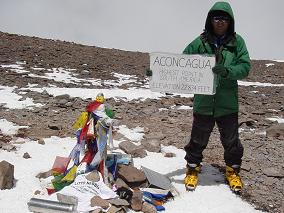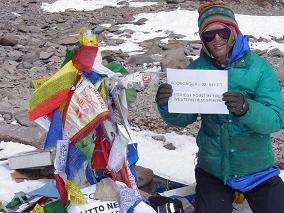
|
Physiological Considerations and Summit Day |

|
obert Greene descended on Day 3.75 - the second morning of our acclimatization period at Base Camp. His overnight headache had progressively worsened, the commonest symptom of inadequate adaptation to high altitude.
Although this vanquishes his hopes for a summit bid, Robert's "demise" poignantly raises the issue of high altitude physiology as yet another, and, likely, the chief obstacle to a successful ascent of Aconcagua - regardless of the route chosen.
The following quotes John Sype regarding his night at Base Camp after we hike to the hotel on Day 4. It underscores how commonplace it is to suffer altitude-related symptoms.
"...My worst night on the mountain was the night after we had hiked to the hotel (at Base Camp). I certainly was still struggling with acclimatizing and I developed for one night (and fortunately only one night) Cheyne-Stokes (periodic) breathing.
This is a breathing pattern that is not uncommonly found at high altitudes, and is driven mainly by hypoxia. In the medical world, it is found in patients with severe cerebral derangements (trauma, cerebral edema, all sorts of encephalopathies, etc...). In fact, Dale (Adam's brother and a neurologist) could probably provide a better definition than myself.
In any event, I am instantly aware of what is occuring. I am not scared or frightened -- I recognize what is happening to my body -- but I am quite annoyed and frustrated. Going through periods of rapid breathing followed by abrubt cessation of breathing for 10-15 seconds makes it very difficult to sleep.
I take 125 mg of Diamox that night and again the following morning. However, I cannot continue the drug. It is such a potent diuretic for me, that I cannot keep on top of my fluid consumption versus urine output. That is in the days when we still use the "Eco-Toilet" outhouse at Base Camp; and I count nine urinations that day. Fortunately, the periodic breathing does not return, and acclimatization proceeds quite well after that."
The ability to acclimatize is absolutely essential for Aconcagua andinistas.3
Nobody is immune from these considerations. If one were, Aconcagua could be climbed in a six-day itinerary with no allowance made to acclimatize:
Were anybody foolish enough to attempt such an itinerary without pre-acclimatization, they would certainly become sick from altitude well before any summit attempt.
Here is the report of an expedition that tried to ascend the Ruta Normal too rapidly.
A completely unacclimatized person who is suddenly transported to 20,000 feet has about ten minutes of what is termed useful consciousness. At 25,000 feet that value drops to just three minutes. Such scenarios have precedent - they can easily occur with aircraft depressurization to both pilots and passengers alike.
It is common for tourists to drive the Pikes Peak road in Colorado from low elevation, and feel no ill-effects apart from the cold and wind at this 14,110 foot summit.
John Sype estimates (and I corroborate) that, in contrast, a person suddenly transported to 16,000 or 18,000 feet will remain conscious - although they will feel quite ill, possibly feeling nauseous as well as lightheaded.
That's it, then - if my commercial flight ever loses cabin pressure, I'll reach for the oxygen mask if the current altitude meets or exceeds 16,000 feet.
Given the above considerations, it is nearly "miraculous" that after several days the Aconcagua climber can and does feel good at Nido de Condores Camp (18,000 feet)! Edward, John, and I feel good at our Lower Condores (17,600 feet) camp. We are able to eat, sleep, relax, and make wisecracks (a sure sign of cognitive function?) seemingly as if at sea level.
However these sensations are in part illusory - it only takes the smallest physical effort, such as gathering snow to melt water; or moving a backpack from "here" to "there", to remind us, with our shortness of breath, that the oxygen level is slightly more than one-half its normal value.4
At Camp Berlin (19,450 feet, 5,930 meters) a similar state-of-affairs exists. We "feel OK" (if not good), and, were we to have had the available time, may possibly have been able to acclimatize to that altitude much as we had successfully achieved at Lower Condores.
Scientific studies have documented that man can temporarily adapt to extreme altidudes in the short term for mountaineering purposes, i.e. over days and possibly even weeks. However there is an upper limit to how high man can adapt for indefinitely long periods. That limit is roughly 5,500 - 6,000 meters (18,050 - 19,700 feet). After a certain period a catabolic state is entered with appetite loss and muscle wasting.
The highest permanent settlements exist in the Peruvian and Bolivian Andes, as well as in the Tibetan highlands. These villages lie at over 15,000 feet - and yet none (that I am aware of) exist higher than 16,000 feet. These elevations corroborate the scientific findings insofar as demonstrating that no society can flourish higher than 5,000 meters (16,400 feet).
3"Andinista" is the South American equivalent of "alpinist" or "climber". The hobby of alpinism is called "el andinismo". In and around Aconcagua you will see these words everywhere - and so it is well to understand them.
4For a standard atmosphere the pressure at 17,500 feet is 51% of its sea level value. To account for the higher temperatures of our austral summer, certain modifications in the detailed calculations suggest a value of 53%.
Physiology and Summit Day

|
n summit day these physiological considerations come down hard on the Aconcagua climber.
However wearing a summit daypack, at some twenty pounds, is far less taxing than a full-sized backpack. With the lighter load I wanted Edward, in the lead, to actually go faster! Indeed, without a heavy pack, my relative lightness suddenly is an advantage, as I obviously have less body weight to "carry" than others. I have noted this phenomenon time and again - suffering under a heavy load until high camp; followed by a considerably easier effort for the actual summit attempt.

|
| John Sype at Aconcagua's summit. |
During the long traverse we climbed from roughly 21,200 feet (my previous "best" altitude from Bolivia's Nevado Illimani), to the Canaleta's base at perhaps 21,900 feet. It was mid-traverse that I start to feel lightheaded. Notably, it is difficult to associate specific people with specific remarks. I can look at a person speaking to me (or to a third individual), and yet somehow the voice and the speaker are strangely disconnected.
This state-of-affairs, reported as well by Edward, was somewhat alarming. I make special effort to concentrate on the tasks at-hand, lest I lose consciousness, slip, and then awaken in some Mendoza hospital.
Cerebral hypoxia is the best description available to explain these symptoms. The extreme altitude takes a toll on our physiology.
We take a good break under this huge, nearly overhanging rock at the base of the infamous Canaleta. The Canaleta, with an average grade of 33 degrees, would not be such a menacing obstacle at a more reasonable elevation. It is the combination of altitude, slope, and loose footing that makes it a favored venue for many climbers who, lacking sufficient resolve, simply give up the fight.
I can be excused for relinquishing the summit for want of good weather. However I refuse to succumb for simple lack of initiative. Eyes on the prize.
We ascend the Canaleta's right (west) edge. I leave my daypack behind, carrying but a summit bagel, Jakk Longacre's ashes, and his eulogy. Several other climbers from other groups also leave their packs under that enormous rock.
Edward slows markedly. We stop every 200-300 vertical feet or thereabouts, providing a complete break in addition to the rest steps that we are already taking. The altitude extracts yet another toll on our physiology.

|
| Edward Earl at Aconcagua's summit. |
Here is an excerpt from Edward's expedition review.
"On summit day I feel the altitude as never before in my life. For the last few hours before reaching the summit I take about 3 or 4 breaths per step. More notably, however, my balance is effected. My reaction time to maintain an upright posture is slowed. Fortunately I climb with an ice axe in one hand and a hiking pole in the other, and I use these to maintain balance.
I feel dazed, as if there is a disconnect between my body and mind. There is definitely less air atop the 22,841 feet of Aconcagua than at the 20,660 feet of Chimborazo or the 20,320 feet of McKinley - as I personally testify. On the latter two peaks, especially McKinley, I approach the summit without breaking stride. I have no such fortune on Aconcagua."
Blessed with a path largely on snow, our progress would have been miserly had we been forced to climb on rock and scree in the gully's middle. Two breaths and then a step. Repeat. Repeat. We continue at this appallingly slow pace until achieving the summit rocks.
I hate walking with crampons on dry rock, as it is extremely awkward. Nonetheless, after some twenty vertical feet of this indignity we all realize this landmark goal - America's highest summit - BAR NONE!
As envisioned in many a daydream, Edward and I embrace with considerable joy - for of the HUNDREDS of mountains we have climbed, THIS is likely to be the most objectively significant peak of all those that we will ever do together.
John, Edward, and I make a three-way handshake. I will not describe the geometry of exactly how that feat is accomplished.
There are only two ways for us to NOT be the highest people on planet Earth. At 2 p.m. local time, it is both winter and nighttime in the great ranges of High Asia. Either a Himalayan expedition establishes a high camp exceeding 7,000 meters in the winter and climbers are sleeping there; or an expedition to one of the other 7,000+ meter ranges of High Asia has run awry, with climbers dangerously near or at the summit in the middle of the night. Himalayan peaks are not normally climbed in the northern winter.
Both of these scenarios as quite unlikely, and, if that is so, we three are, for the moment, the highest live humans on Earth.
As described in footnote 5, a French alpinist dies while attempting the summit of Makalu (8,481 meters) the day prior to our summit bid. A dead man does not void our claim to be the very highest.
To recap, at 22,841 feet elevation Aconcagua is, at-once:
Aconcagua's summit sports a mere 41% of sea level pressure under standard conditions - some 12 1/4 inches of mercury compared with roughly 30 at sea level. Understandably then, reaching this lofty perch requires considerable adaptation and resolve.
The very highest point is a flat boulder of roughly four square feet. I sit on it while delivering the summit eulogy for Jakk Longacre. The combined land area of North and South America is some 15,000,000 square miles. As the boulder's area is but one-hundred trillionth of this value (10-14), it is no coincidence that I elect to rest there amongst all possible places to sit on the American landmass!

|
| Adam Helman at Aconcagua's summit. |
I digress. My mentation returns to a semblance of normalcy once below some critical, mid-traverse elevation of 21,500 feet. Edward notes that his sensation of lightheadness never occurred to him on Mount McKinley. Small wonder, of course, as Aconcagua is 2,500 feet higher still. He likens the feeling to being enebriated. Since Edward does not drink he can be excused for making such a comparison: for my sake the two feelings, albeit similar in constitution, are indeed different.
The following morning we sleep late enough for the tent to receive direct sunlight, at about 8:30 a.m., prior to arising. This warms the air enough to make going outdoors far less contemptuous than otherwise.
I want to make this a rest day - after all, we are now four entire days ahead of schedule since only one of five summit days was used to that end. I request my usual two Motrin tablets from John (200 mg each), and my mild headache disappears yet again.
"We gotta get outa here", I mutter. Edward replies, "Camp Berlin is no place to tarry." And with that agreement we break camp and head downhill for Base Camp.
The air at 14,300 feet can be luxuriously thick once you have been far higher still. That said, it only takes one uphill stroll to recall that we were not in Kansas ... yet.
| previous page - The Physical Effort | next page - Mental, Emotional, and Personal Issues |